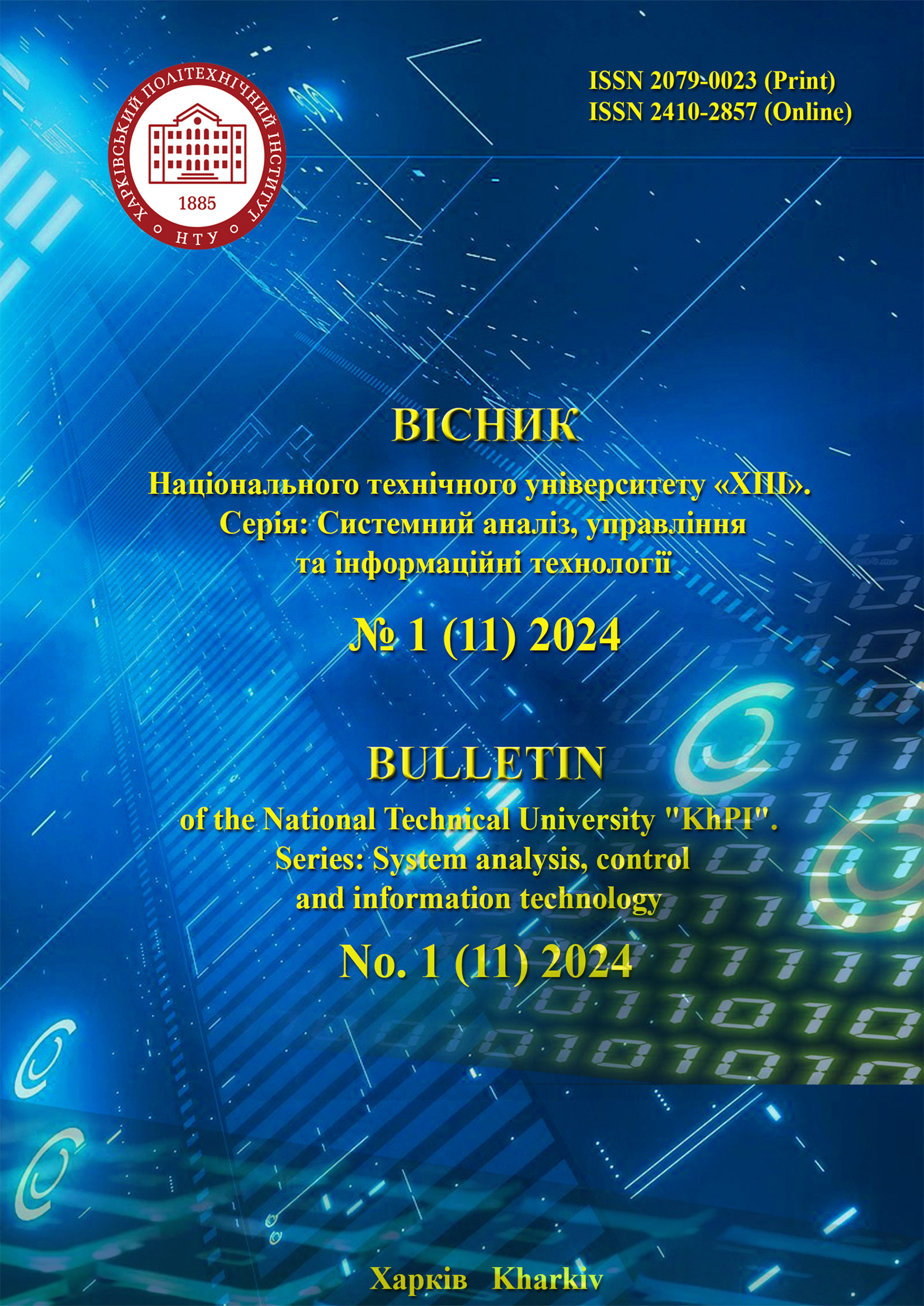MULTI-AGENT SIMULATION MODEL OF INFECTIOUS DISEASE SPREAD
DOI:
https://doi.org/10.20998/2079-0023.2024.01.07Keywords:
epidemic, simulation modeling, model, SARS-CoV-2, pandemic, forecasting, mathematical modelingAbstract
The aim of the research is to develop a multi-agent simulation model for predicting the spread of infectious diseases, particularly COVID-19. In the context of the COVID-19 pandemic, there emerged an urgent need to create tools for forecasting and analyzing the dynamics of epidemics, as well as for evaluating the effectiveness of management decisions. The use of mathematical models in this process allows for an adequate description of the infection spread dynamics, which is essential for making informed decisions. The article discusses traditional approaches to epidemic modeling, such as the predator-prey model and the compartmental SIR (Susceptible-Infectious-Recovered) model. The predator-prey model describes the interaction between two species in an ecosystem using differential equations, which allows for modeling population dynamics. The compartmental SIR model divides the population into three groups: susceptible, infected, and recovered, which enables the analysis of the spread of infectious diseases. However, these models have limitations, particularly due to assumptions about population homogeneity and constant parameters. To more accurately model complex epidemic processes, a multi-agent simulation model was developed. In this model, agents interact within a defined area, mimicking real conditions of infection spread. Agents are divided into three classes: healthy, infected, and recovered. The movement of agents is modeled using random walk in a two-dimensional space, taking into account the possibility of contact between them, which can lead to infection. Infected agents transition to the recovered class after a certain period of illness and can no longer be infected. Modeling results showed that the multi-agent model allows for more accurate prediction of infection spread dynamics. Numerous experiments were conducted, demonstrating the model's adequacy in replicating the infection process, peak infection rates, and recovery periods. The influence of various parameters, such as the duration of illness, on the epidemic dynamics was investigated. The obtained results confirm that considering individual characteristics and behavioral traits of agents improves the accuracy of modeling. This allows the multi-agent simulation model to be used for developing effective control strategies and predicting the spread of infectious diseases, which can be useful for making management decisions in real pandemic conditions.
References
Ivanov M. V. Matematicheskoe modelirovanie processa pandemii: teoriya i praktika [Mathematical modeling of the pandemic process]. Available at: https://indsi.ru/2020/04/30/ математическое-моделирование-проце/ (accessed: 15.11.2020). (In Russ.).
Ivashchenko D. S., Kutsenko O. S. Ohliad i analiz metodiv modeliuvannia protsesu rozvytku epidemii [Review and analysis of methods for modeling the development of the epidemic]. Visnyk Natsional'noho tekhnichnoho universytetu «KhPI». Seriya: Systemnyy analiz, upravlinnya ta informatsiyni tekhnolohiyi [Bulletin of the National Technical University "KhPI": a collection of scientific papers. Ser.: System analysis, control and information technology]. 2021, no. 1 (5), pp. 16–19. (In Ukr.).
Mastikhin A. V. (2011). Final’nye veroyatnosti dlya markovskih processov epidemii: dys. … kand. fyz.-mat. nauk: 01.01.05 [Finalny imovirnosty for Markov processes of the Epidemic: dissertation of candidate of physical and mathematical sciences: 01.01.05 (PhD)]. Moscow, 2011. 93 p. (In Russ.).
Avilov K. Matematicheskoe modelirovanie v epidemiologii kak zadacha analiza slozhnyh dannyh [Mathematical modeling in epidemiology as a problem in the analysis of complex data]. Aviable at: http://download.yandex.ru/company/experience/seminars/ KAvilovmatmodelirovanie.pdf (accessed 07.04.2021).
Allen L. J. An Introduction to stochastic epidemic models. URL: http://eaton.math.rpi.edu/csums/papers/epidemic/allenstochasticepidemic.pdf (accessed 03.04.2021).
Aponin Y. M., Aponina E. A. Matematicheskaya model soobshestva hishnik – zhertva s nizhnim porogom chislennosti zhertvy [Mathematical model of a predator – prey community with a lower threshold for the number of prey]. Kompyuternye issledovaniya i modelirovanie [Computer research and modeling]. 2009, no. 1, pp. 51–56. (In Russ.).
Evans C., Findley G. A new transformation for the Lotka – Volterra problem. Journal of Mathematical Chemistry. 1999, no. 25 (1), pp. 105–110.
Fort H. On predicting species yields in multispecies communities: Quantifying the accuracy of the linear Lotka-Volterra generalized model. Ecological Modelling. 2018, vol. 387, pp. 154–162. DOI: https://doi.org/10.1016/j.ecolmodel.2018.09.009.
Gray A., Greenhalgh D., Mao X., Pan J. The SIS epidemic model with markovian switching. URL: http://strathprints.strath.ac.uk/41322 (accessed 10.03.2021).
Asatryan M. N., Salman E. R., Boev B. V. Modelirovaniya i prognozirovaniya epidemicheskogo processa gepatita B [Model and prognosis of the hepatitis B]. Epidemiology and vaccine prophylaxis. 2012, no. 1 (62), pp. 49–54. (In Russ.).
Carley K. M., Altman N., Kaminsky B., Nave D., Yahja A. BioWar: A City-Scale Multi-Agent Network Model of Weaponized Biological Attacks. CASOS Technical Report 2004. URL: http://www.casos.cs.cmu.edu/publications/papers/carley_2004_biowarcityscale.pdf (accessed 17.10.2020).
Bellu G., Saccomani M. P., Audoly S., Daisy D. L. A new software tool to test global identifiability of biological and physiological systems. Computer Methods and Programs in Biomedicine. 2007, vol. 88, no. 1, pp. 52–61.
Downloads
Published
How to Cite
Issue
Section
License

This work is licensed under a Creative Commons Attribution 4.0 International License.
Authors who publish with this journal agree to the following terms:
- Authors retain copyright and grant the journal right of first publication with the work simultaneously licensed under a Creative Commons Attribution License that allows others to share the work with an acknowledgement of the work's authorship and initial publication in this journal.
- Authors are able to enter into separate, additional contractual arrangements for the non-exclusive distribution of the journal's published version of the work (e.g., post it to an institutional repository or publish it in a book), with an acknowledgement of its initial publication in this journal.
- Authors are permitted and encouraged to post their work online (e.g., in institutional repositories or on their website) prior to and during the submission process, as it can lead to productive exchanges, as well as earlier and greater citation of published work (See The Effect of Open Access).


